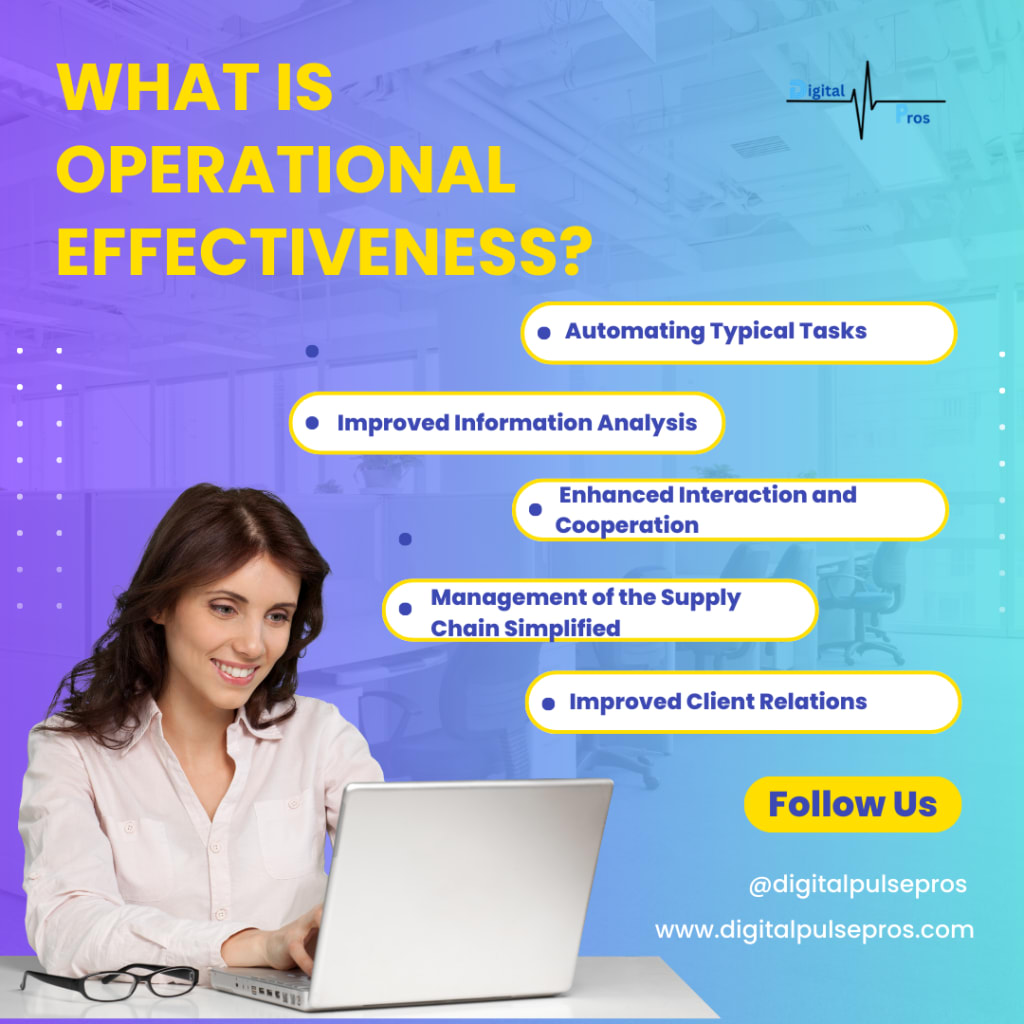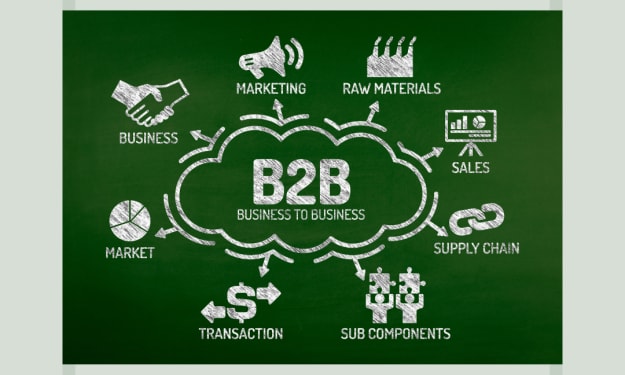WHAT IS OPERATIONAL EFFECTIVENESS?
Operational effectiveness is more than just a catchphrase in today’s fiercely competitive business environment

Why Operational Effectiveness Is Important
Cost reduction: Organizations can cut waste and operational expenses by optimizing their procedures. This boosts profitability and enables businesses to provide competitive pricing without compromising quality.
Enhancing Quality: Robust operations guarantee that goods and services either fulfill or surpass the expectations of clients. Positive word-of-mouth, client happiness, and loyalty are all correlated with high-quality production.
Resource Utilization: A company can accomplish more with less when its resources—human, financial, or material—are used efficiently. This boosts production while also conserving resources.
Competitive Advantage: By providing customers with greater value, businesses that excel in operational performance can surpass rivals. In marketplaces where products and services are essentially comparable, this can be a crucial differentiation.
Sustainability: By cutting waste and energy use, efficient operations support worldwide initiatives to lessen their negative effects on the environment.
Methods for Improving Operational Efficiency
Process Enhancement:
Lean Management: Use lean concepts to cut down on waste and optimize workflows. To increase efficiency, this calls for ongoing workflow assessment and improvement.
Six Sigma: Use Six Sigma techniques to lower variance and raise quality. This data-driven methodology aids in finding and fixing process flaws.
Integration of Technology:
Automation: To cut down on human labor and boost accuracy, take advantage of automation technologies. Employees can concentrate on more strategic duties as automated systems take care of monotonous jobs.
Data analytics: To learn more about operational performance, use data analytics. Data-driven decision-making is made possible by the identification of areas for improvement and bottlenecks through data analysis.
Training and Development for Employees:
Enhancement of Skills: Make training programs an investment to give staff members the tools they need to work effectively. A staff with proper training can adjust to changing procedures and technology and is more productive overall.
Empowerment: Invite staff members to point out inefficiencies and make suggestions for enhancements. Employees that feel empowered are more involved and take the initiative to improve operational effectiveness.
Management of the Supply Chain:
Vendor Relationships: Establish solid bonds with vendors to guarantee prompt and economical material procurement. Reliable supply chains and better terms can result from cooperative collaborations.
Inventory Control: Use efficient inventory control techniques to strike a balance between supply and demand. Just-In-Time (JIT) methods, for example, can minimize excess inventory and save holding costs.
Client-Side Focus
Feedback Loops: Create channels for customer feedback to learn about their requirements and preferences. Reviewing client feedback on a regular basis aids in process improvement to better satisfy customers.
Service Excellence: To improve the entire customer experience, give priority to customer service. Customer satisfaction can be greatly increased by efficient operations that shorten wait times and enhance the quality of the services.
Toyota’s Operational Excellence: A Case Study
Toyota is frequently used as an example of an operationally efficient company. The automobile industry saw a revolution when businesses implemented lean manufacturing methods, which are referred to as the Toyota Production System (TPS). Toyota continuously manufactures high-quality cars while cutting costs by putting an emphasis on continuous improvement (Kaizen) and getting rid of waste. Their achievement serves as a reminder of how crucial operational effectiveness is to gaining a sustained competitive edge.
How does technology integration help in achieving operational effectiveness?
The following are some ways that technology integration contributes to operational effectiveness:
1. Automating Typical Tasks
Robotic process automation (RPA) and machine learning are two examples of automation technologies that can perform repetitive jobs accurately and efficiently. This lessens the chance of human error while simultaneously lightening the workload for staff members. For instance, automated payroll and invoicing systems can handle massive amounts of data efficiently and precisely, freeing up staff members to concentrate on more strategic tasks.
2. Improved Information Analysis
With the use of data analytics tools, organizations may gather, handle, and evaluate enormous volumes of data. Through the analysis of this data, entities can discern patterns, pinpoint inadequacies, and arrive at well-informed conclusions. For instance, demand can be predicted using predictive analytics, which enables businesses to better manage their inventory and lower the costs of overstocking or stockouts.
3. Enhanced Interaction and Cooperation
Regardless of where team members are located, technology solutions like cloud computing and collaboration platforms (like Microsoft Teams and Slack) can improve communication and teamwork. Real-time information and resource sharing are made possible by these solutions, which promotes improved teamwork and quicker decision-making.
4. Management of the Supply Chain Simplified
Businesses can monitor and manage their supply networks more efficiently with the use of advanced supply chain management software. Real-time inventory and shipment tracking is made possible by technologies like Internet of Things (IoT) devices, which guarantee improved inventory control and on-time delivery. Lead times are shortened as a result, and operating expenses are decreased.
5. Improved Client Relations
AI-driven chatbots and customer relationship management (CRM) platforms enhance customer service by offering individualized and effective assistance. Higher levels of customer satisfaction and loyalty can result from these technologies’ ability to manage client contacts, track preferences, and anticipate future demands.
6. Greater Scalability and Flexibility
Because cloud-based solutions are flexible and scalable, companies may expand their operations without having to make large upfront investments and swiftly adjust to shifting market conditions. Maintaining operational performance in a dynamic business environment requires this agility.
7. Sturdy Cybersecurity Protocols
Sophisticated cybersecurity solutions can be integrated to safeguard confidential information and preserve the integrity of corporate processes. Robust security measures, such intrusion detection systems, multi-factor authentication, and encryption, are crucial for protecting company assets and guaranteeing uninterrupted operations in light of the growing threat posed by cyberattacks.
8. Better Management of the Workforce
Payroll, performance management, onboarding, and recruitment are just a few of the HR procedures that are made easier by HRMSs and other labor management technologies. By putting the right people in the proper jobs and maximizing their performance, these technologies aid in more efficient workforce management.
What role do employees play in operational effectiveness?
In order to achieve and sustain operational performance, employees are essential. Their engagement, aptitudes, and dispositions have a big influence on how well an organization runs. Employees are essential to maintaining operational performance in the following ways:
1. Carrying Out Optimized Procedures
The people who do the routine duties and procedures in an organization are its employees. Their devotion to best practices and defined procedures guarantees the seamless and effective functioning of activities. Employees with proper training may carry out their tasks precisely, reducing mistakes and increasing output.
2. Recognizing Inefficiencies
Workers with firsthand experience with operating procedures are frequently the ones to identify inefficiencies or bottlenecks. Employees can communicate their findings and recommend changes when a culture of open communication and continuous development is fostered. Operational effectiveness can be significantly improved by taking a proactive approach.
3. Putting Continuous Improvement Into Practice
Kaizen and other continuous improvement approaches depend on staff members at all levels taking an active role in the process. Workers can help by pointing out tiny, gradual adjustments that add up to significantly higher productivity and quality. Participation in these programs cultivates a sense of responsibility and dedication to the objectives of the company.
4. Adjusting to the Integration of Technology
Employees need to be flexible enough to adjust to changes in the workplace when companies implement new technology to improve operational effectiveness. This entails picking up new skills and methods that can boost their output and the organization’s general effectiveness. Employees must get ongoing training and assistance in order to successfully complete these transitions.
5. Making Certain Quality Assurance
Workers are essential to preserving and raising the quality of goods and services. They contribute to ensuring that the output meets or exceeds client expectations by adhering to quality control protocols and quickly reporting any problems. Their focus on quality and attention to detail are essential for efficient operations.
6. Working Together Throughout Departments
Smooth departmental coordination is typically necessary for operational effectiveness. Workers that are good communicators and collaborate well with coworkers in other departments within the company can contribute to process simplification, delay reduction, and increased productivity. For operations to be optimized, cross-functional cooperation is necessary.
7. Adopting a Customer-Centric Perspective
Workers that deal with consumers on a daily basis might offer insightful information about their requirements and preferences. They assist the company in improving its operations to better match customer expectations by concentrating on providing exceptional customer service and obtaining feedback. This customer-focused strategy is essential to maintaining operational effectiveness over the long run.
Conclusion
A key component of a successful firm is its operational efficiency. Businesses can achieve excellent operational performance through process optimization, technology integration, staff development, efficient supply chain management, and a strong customer focus. Investing in operational effectiveness is not only advantageous but also necessary in a time when quality and efficiency are of the utmost importance. Adopt these tactics to improve the functioning of your company and realize the full potential of your enterprise.
FAQs:
1. Is operational efficacy a factor in sustainability?
Indeed, operational effectiveness helps sustainability initiatives by maximizing resource use and avoiding waste, which lessens the environmental impact of business operations.
2. How may operational performance be improved by effective supply chain management?
Smoother operations are a result of effective supply chain management, which guarantees timely material acquisition, keeps inventory levels in check with demand, and cultivates strong vendor relationships.
3. Why is operational effectiveness dependent on a customer-focused approach?
Businesses can improve customer satisfaction and loyalty by refining their operations to better match consumer expectations and focusing on client demands and feedback.
About the Creator
digitalpulsepros
Digital Pulse Pros is your go-to destination for insightful articles on all things digital marketing. Whether you’re a seasoned professional or just dipping your toes into the digital world.
Enjoyed the story? Support the Creator.
Subscribe for free to receive all their stories in your feed. You could also pledge your support or give them a one-off tip, letting them know you appreciate their work.






Comments (1)
Thank you I am happy with your exciting stories Watch my stories now